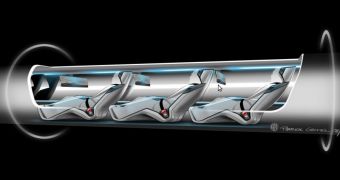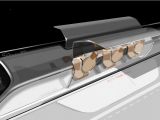Elon Musk, the founder of SpaceX and co-founder of Tesla Motors and PayPal, recently proposed the development of a new type of vehicle, capable of transporting people between Los Angeles and San Francisco in about 35 minutes.
His machine is meant to be an alternative to the four major categories of vehicles in use today: airplanes, trains, cars and boats. Dubbed the Hyperloop, the new vehicle would operate on different principles, with significant financial savings.
Other benefits include faster traveling times, increased passenger safety, more convenience to the user, independence with regards to the weather, energy efficiency and savings, earthquake resistance and little to no disruptions for those along the way.
Musk proposes that this high-speed transit concept be achieved via a series of underground, low-pressure steel tubes, traveled by special pods capable of reaching speeds of up to 760 miles per hour (1,220 kph).
In terms of propulsion, the Hyperloop would use magnetic linear accelerators to move the travel pods from their stations to the main travel line, and then boost their speed at regular intervals using efficient linear induction motors built right into the tube and pods themselves. This type of intermittent acceleration will contribute to keeping the system very energy-efficient.
In order to reduce any friction that might occur, a cushion of compressed air will separate the travel pods from the surface of the tubes. This type of construction will also enable constructors to scale up the system, in the sense that future generations of travel pods may be able to accommodate an entire car or SUV, passengers included.
For portions of the route where the tubes are exposed, solar panels can be added onto the structures to produce electricity. According to Musk, early calculations indicate that such an arrangement would provide more than enough energy to keep the entire system running during the day, without it having to be hooked up to a conventional power grid.
Musk envisions the Hyperloop linking any pair of cities located less than 1500 kilometers or 900 miles away from each other. Beyond this distance, it is very likely that taking an airplane would prove more economical and feasible.
However, the system would work perfectly for shorter distances. Musk estimates that a working Hyperloop system between San Francisco and Los Angeles could take up to 10 years to build, allotting most of this time to testing the new technologies in the project.
“The vehicle is streamlined to reduce drag and features a compressor at the leading face to ingest oncoming air for levitation and to a lesser extent propulsion. Aerodynamic simulations have demonstrated the validity of this ‘compressor within a tube’ concept,” Musk writes in his presentation.
“The overall cost of the Hyperloop passenger capsule version is expected to be under $1.35 million USD (€989,000) including manufacturing and assembly cost. With 40 capsules required for the expected demand, the total cost of capsules for the Hyperloop system should be no more than $54 million USD (€39.3 million),” at a cost of $20 (€15) per ticket, Musk concludes.

 14 DAY TRIAL //
14 DAY TRIAL // 
